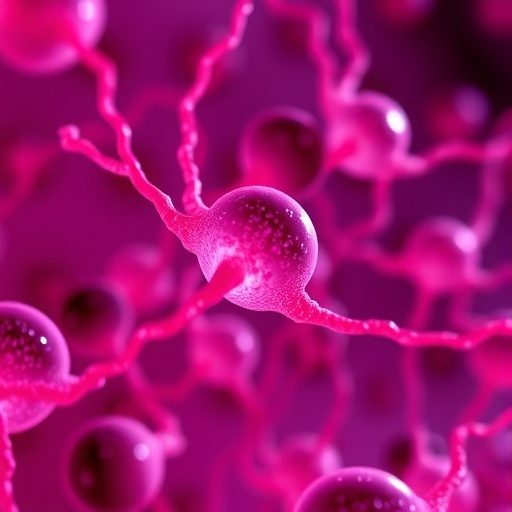The intricate wiring of the spleen with the nervous system has recently come into focus, revealing a complex neuroimmune interface that plays a pivotal role in both organ development and immune functionality. This newfound understanding underscores the spleen not only as a lymphoid organ but as a dynamic nexus where neural signals finely tune immune responses, with profound implications for disease management and organ engineering. The sympathetic nervous system, in particular, emerges as a vital player, modulating immune activity through precise anatomical and molecular interactions.
Deep within the anatomy of the spleen, sympathetic postganglionic axons extend their reach via the splenic nerve, their cell bodies anchored in the prevertebral ganglia. These nerve fibers closely follow the branches of the splenic artery, predominantly innervating the white pulp, the immunologically active region of the spleen, and occasionally the marginal zones that interface various immune cells. The sympathetic input forms a sophisticated relay with preganglionic fibers traveling through the greater splanchnic nerve, originating from the thoracic spinal cord segments T9 to T11. This orchestrated neural routing is essential for conveying central nervous system signals to modulate spleen activity.
Interestingly, while the sympathetic innervation of the spleen is well documented and understood, the parasympathetic counterpart remains elusive and controversial. Historical and contemporary data suggest minimal parasympathetic contributions, raising questions about the extent and functionality of these pathways. This difference in autonomic input underlines the spleen’s special reliance on the sympathetic system as a critical regulatory modality, a notion that reshapes traditional views of autonomic control in lymphoid organs.
The timeline of spleen innervation also offers revealing insights into organ maturation. In rodent models, noradrenergic fibers begin infiltrating the white pulp immediately at birth. These fibers proliferate in tandem with structural expansions of splenic compartments, notably encircling emerging lymphoid follicles. As the spleen develops, these nerve fibers organize into precise networks within the periarteriolar lymphoid sheaths (PALS), a specialized region that houses T lymphocytes. This progressive establishment of sympathetic innervation from neonatal stages onwards corresponds with shifting immune landscapes and cellular distributions, highlighting neurodevelopmental influences on immune readiness.
Analogous patterns have been observed in humans, where the splenic nerve—composed predominantly of sympathetic noradrenergic fibers emerging from the celiac ganglion, suprarenal ganglia, and thoracic sympathetic chain—provides the primary neural input. These sympathetic neurons form the backbone of neural control over spleen-mediated immune functions, regulating not just lymphocyte distribution but also the activity of a broad spectrum of immune cells. Contrastingly, parasympathetic neurons in the human spleen are scarce, and the seemingly underexplored parasympathetic innervation invites further research into its potential roles.
Crucial to immune homeostasis, sympathetic innervation modulates innate immunity by influencing the behavior of natural killer cells, dendritic cells, macrophages, and diverse leukocyte subsets. During episodes of acute inflammation, norepinephrine (NE) released from sympathetic nerve terminals binds specifically to β-adrenergic receptors on macrophages. This interaction suppresses the production of tumor necrosis factor-alpha (TNF-α), a pro-inflammatory cytokine, in response to endotoxemic challenges. Such adrenergic downregulation of inflammatory responses demonstrates how the nervous system exerts anti-inflammatory control to prevent excessive immune activation.
Stress responses further showcase the significance of sympathetic pathways in immune modulation. Activation of sympathetic nerves during stress results in diminished cytokine secretion, effectively dampening the systemic inflammatory milieu. Experimental interventions like splenic nerve resection abolish this immune suppression, underscoring the indispensable role of intact sympathetic signaling for the neuroimmune reflex. These findings reveal the spleen as a key effector organ in the body’s response to stress and inflammatory insults, mediated through its neural innervation.
Neurological injuries impose severe disruptions on splenic innervation, leading to pathological immune consequences. Damage to the nervous system that impairs splenic nerve fibers causes a cascade of immune dysfunctions: elevated levels of norepinephrine, increased apoptosis of splenic immune cells, impaired antibody production, and heightened susceptibility to infections. This constellation of deficiencies highlights how delicate the neuroimmune balance is and the vulnerability of immune competence to nervous system integrity.
In the context of spinal cord injury, aberrant neural plasticity below the lesion site can result in a hyperactive anti-inflammatory reflex circuit. This maladaptive response perpetuates chronic immune suppression by constantly overactivating the sympathetic efferents to the spleen. Such persistent suppression is clinically significant as it increases the risk of infections in injured patients, revealing how neuroimmune circuits can be dysregulated long after initial neural trauma.
The emerging recognition of the spleen’s nerve center opens exciting avenues for organ bioengineering and immunomodulation therapeutics. By harnessing or mimicking the neural pathways that govern spleen function, future interventions might precisely control immune responses in transplantation, autoimmune disorders, and infectious diseases. This neurocentric perspective aligns with the broader field of bioelectronic medicine, aiming to exploit the nervous system’s regulatory powers to restore or enhance physiological processes.
Despite these advances, numerous questions remain open, especially in delineating the exact parameters, neurotransmitters, and receptors involved in the spleen’s autonomic control. The elusive parasympathetic input, which has been historically posited but remains poorly elucidated, invites thorough investigation. Understanding these crosstalk mechanisms at cellular and molecular levels could uncover novel therapeutic targets that better regulate immune competence and inflammation.
Moreover, the identification of specific sympathetic pathways that target distinct immune cell populations within splenic compartments reveals a spatial and functional complexity previously unappreciated. Mapping these precise neuroimmune interactions across development and in response to pathophysiologic states is crucial to fully harness the benefits of organ innervation research.
The implications for clinical neurology and immunology are vast. Persistent immune suppression following nerve injury or stress-related dysregulation could be clinically managed through targeted neurostimulation or pharmacological manipulation of splenic nerve activity. Such interventions would represent a paradigm shift in treating immunodeficiency secondary to neurological insult or chronic inflammatory diseases.
In summary, the spleen serves as a dynamic interface between the nervous and immune systems, orchestrated predominantly by sympathetic innervation. This neuroimmune nexus regulates immune cell function, organ development, and systemic inflammation, opening new frontiers in understanding how neural circuits influence immunity. The delicate balance maintained by these neural signals, susceptible to disruption in disease and injury, highlights a critical area ripe for therapeutic exploration in the evolving landscape of organ engineering and regenerative medicine.
Subject of Research: Neural innervation and immune regulation in the spleen
Article Title: The nerve center of organ engineering
Article References:
Das, S., Gordián-Vélez, W.J., Dave, J.R. et al. The nerve center of organ engineering. Nat Commun 16, 9834 (2025). https://doi.org/10.1038/s41467-025-64801-4
Image Credits: AI Generated
DOI: https://doi.org/10.1038/s41467-025-64801-4
Tags: anatomy of the spleencentral nervous system and spleen regulationimplications for disease management and organ developmentneural modulation of immune responsesorgan engineering and immune functionalityparasympathetic innervation of spleenprevertebral ganglia and spleenspleen neuroimmune interfacesplenic nerve and immune interactionsympathetic nervous system in spleensympathetic postganglionic axons in spleenwhite pulp and immune activity





